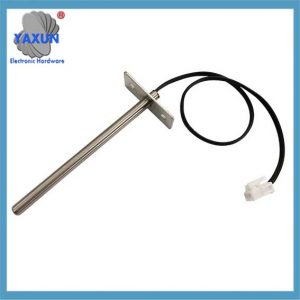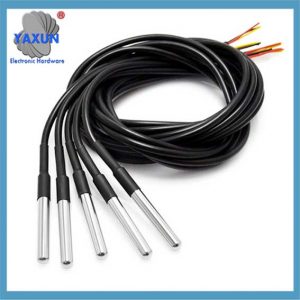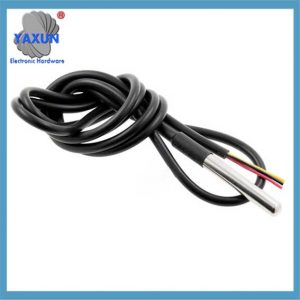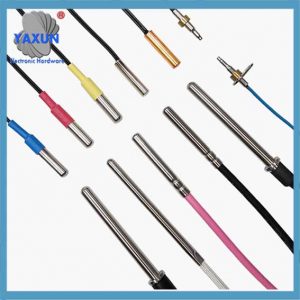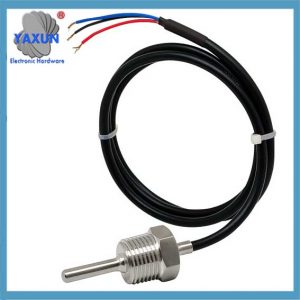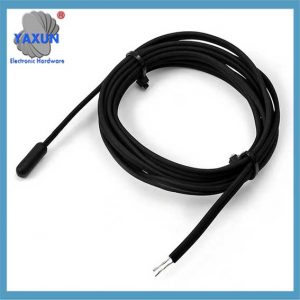In modernen Anwendungen der Sensorik, (NTC, PTC, PT100, Thermoelement, thermischer Widerstand, DS18B20, usw. Kabel, Sondenset) Temperatursensoren sind wichtige Messgeräte. Sie werden häufig in der industriellen Automatisierung eingesetzt, Landwirtschaftliche Überwachung, Automobilbau und andere Bereiche. Um sicherzustellen, dass der Temperatursensor in einer feuchten oder nassen Umgebung stabil und zuverlässig arbeiten kann, waterproof and moisture-proof technology has become an important design point. The following are several technical points for waterproof and moisture-proof of temperature sensors:
1. Package design
Packaging materials: Waterproof and moisture-proof temperature sensors usually use high-performance packaging materials. These materials have excellent waterproof and moisture-proof properties. Common packaging materials include corrosion-resistant metals (such as stainless steel) and engineering plastics (such as polytetrafluoroethylene). They can effectively isolate moisture and liquids and protect internal electronic components from damage.
Sealing technology: In order to enhance the waterproof and moisture-proof performance, sealing technology such as O-rings, silicone sealing rings or epoxy resin potting is used in the package. These sealing measures can prevent water and moisture from entering the sensor through seams or openings, thereby improving its environmental adaptability.
2. Protection level
IP level: The waterproof and moisture-proof performance of the temperature sensor is often expressed by the IP (Ingress Protection) level. The IP level consists of two numbers, the first number indicates the protection level against solid substances, and the second number indicates the protection level against liquids. Zum Beispiel, IP67 means that the sensor is completely dustproof and can work normally within 30 minutes of immersion in 1 meter of water.
Corrosion-resistant coating: In some particularly harsh environments, such as chemical plants, sensors may be exposed to corrosive substances. For this reason, a corrosion-resistant coating may be applied to the surface of the sensor to further enhance its protection.
3. Material selection
Corrosion-resistant materials: In order to cope with possible corrosion problems in humid environments, sensors are usually made of corrosion-resistant materials. Zum Beispiel, Edelstahl (wie zum Beispiel 304 or 316L stainless steel) has excellent corrosion resistance and is suitable for use in wet and acid-base environments.
Insulating materials: The insulating materials of internal electronic components must also have excellent moisture resistance. High-quality insulating materials can prevent moisture from penetrating into the circuit of the sensor, thereby avoiding short circuits or damage.
4. Structural design
Vent hole design: In order to prevent the package from breaking due to changes in internal air pressure caused by temperature changes, waterproof and moisture-proof temperature sensors are often designed with vent holes. These vent holes use microporous membranes or breathable materials to allow internal gas to be discharged freely while not allowing moisture and dust to enter.
Fastening structure: The connection part and fixed structure design of the sensor also need to consider waterproof and moisture-proof factors. Through reasonable fastening and fixing methods, moisture is prevented from entering the sensor through the connection points.
5. Testing and certification
Environmental testing: In order to ensure the waterproof and moisture-proof performance of the sensor, strict environmental testing is usually required. These tests include immersion tests, high humidity environment tests, and temperature change tests to ensure that the sensor can work stably under various harsh environmental conditions.
Certification standards: The waterproof and moisture-proof performance of the sensor is often certified according to international standards, such as ISO 20653 or IEC 60529. These certification standards provide detailed requirements for protection levels and test methods to help ensure that the product meets the requirements of protection performance.
Summary
The waterproof and moisture-proof technology of the temperature sensor is the key to ensuring its stable operation in complex environments. By optimizing the packaging design, selecting the right materials, improving the structural design and conducting rigorous testing and certification, the environmental adaptability of the sensor can be effectively improved. These technical points not only improve the durability of the sensor, but also ensure its reliability and accuracy in various wet or humid environments.
 English
English العربية
العربية Български
Български 粤语
粤语 中文(简体)
中文(简体) 中文(漢字)
中文(漢字) Nederlands
Nederlands Suomi
Suomi Français
Français Deutsch
Deutsch Ελληνικά
Ελληνικά Magyar
Magyar Italiano
Italiano 日本語
日本語 한국어
한국어 Polski
Polski Português
Português Română
Română Русский
Русский Slovenščina
Slovenščina Español
Español Svenska
Svenska ภาษาไทย
ภาษาไทย Türkçe
Türkçe Tiếng Việt
Tiếng Việt
